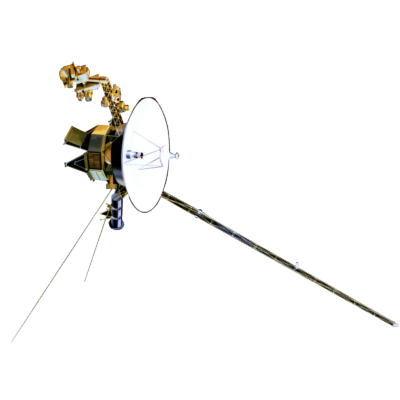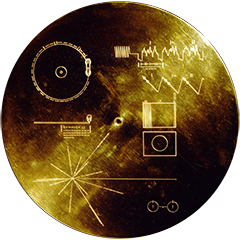VOYAGER
Voyager LECP Data Analysis Handbook
Data File Descriptions
Master Pulse (Tape) File Descriptions
TABLE A2. DESCRIPTION OF MASTER PULSE TAPE HEADER VARIABLES
| ITEM | DESCRIPTION | |
|---|---|---|
| 1 | MODE |
Contains the telemetry mode |
| 2 | SCID |
Spacecraft Identification - identifies the
spacecraft transmitting this data Spacecraft Event Time - contains the Greenwich Mean Time of the readout of the first bit of the first spacecraft minor frame used in this LECP major frame |
| 3 | SCETH | Spacecraft Event Time, Hour - number of hours since the beginning of the current year plus 24. For the one hour interval Jan 1, 0000-0059 UT, SCET=24. The Day of Year may be computed using DAY=(SCETH/24). |
| 4 | SCETS | Spacecraft Event Time Sec - is the number of seconds since the beginning of the current hour |
| 5 | SCETMS | Spacecraft Event Time, Milliseconds - is the number of milliseconds since the beginning of the current second |
| 6 | SCETY | Spacecraft Event Time, Year - contains the last two digits of the current year (i.e., 77, 78) |
| 7 | NSMR | Number of Supplemental Records - specifies the number of supplemental records that will follow the current record. |
| 8 | SCETF | Spacecraft Event Time Flag - indicates that the spacecraft clock has been corrected in some manner in the J.P.L. processing. Bit 0 indicates correction to the line counter (0=none, 1=corrected), bit 1 the MOD60 counter and bit 2 the MOD216counter. |
| 9 | MOD216 | Mod216 Spacecraft Clock Word - contains the spacecraft Mod216word for the first minor frame of the current record. This word is incremented every 48 minutes on the overflow of the Mod60 counter. |
| 10 | MOD60 | Mod60 Spacecraft Clock Word - contains the spacecraft Mod60 word for the first minor frame of the current record. It has a range of 0 to 59 and is incremented every 48 seconds at the overflow of the line counter. |
| 11 | LC | Spacecraft Line Counter - contains the line count for the first minor frame in the current record. LC ranges from 1 to 80010 and is incremented every 0.06 seconds. |
| 12 | S1 | LECP Status Word 1 |
| 13 | S2 | LECP Status Word 2 |
| 14 | S3 | LECP Status Word 3 |
| 15 | S4 | LECP Status Word 4 |
| 16 | S5 | LECP Status Word 5 |
| 17 | S6 | LECP Status Word 6 |
| 18 | MP | LECP Motor Position - contains the motor position at the end of the current record. Bit 0 (LSB) is set if the motor is centered, bits 1-3 contain the motor position (0=sector 1, ..., 7=sector 8). If the motor position is unknown MP=-1. |
| 19 | NMF | Number of Minor Frames - contains the number of minor frames used to make up the current LECP record. |
| 20 | LATEMP | LECP Log. Amp. Temperature - contains the log. amp. temp (Co) x 128. If the temperature is unknown LATEMP = -9999 |
| 21 | TTEMP | LECP Telescope Temperature - contains the telescope temperature (Co) x 128. If the temperature is unknown TTEMP= -9999. |
| 22 | NPHA | Number of PHA Readouts - contains the number of PHA readouts in the current major frame. |
| 23 | NG | Number Groups - indicates the number of rate groups included in the current major frame. |
| 24 | MRT/MPT/SEDR | Master Rate Tape/Master Pulse Tape -
indicates whether this record is a master rate or
master pulse record. 01 = Master Rate Record, 02 = Master Pulse Record, 04 = SEDR, 10 = ENG, 11 = CAL |
| 25 | VN | Version number - indicates the version of S1P used to process the current data. |
Return to MPT main page.
Return to Data File Descriptions main page.
Return to Voyager
LECP Data Analysis Handbook Table of Contents.
Return to Fundamental
Technologies Home Page.
Updated 8/9/19, Cameron Crane
VOYAGER 1 ELAPSED TIME
--:--:--:--
Days: Hours:
Minutes: Seconds
*Since official launch
September 5, 1977, 12:56:00:00 UTC
*Since official launch
September 5, 1977, 12:56:00:00 UTC
VOYAGER 2 ELAPSED TIME
--:--:--:--
Days: Hours:
Minutes: Seconds
*Since official launch
August 20, 1977, 14:29:00:00 UTC
*Since official launch
August 20, 1977, 14:29:00:00 UTC
QUICK FACTS
Manufacturer:
Voyagers 1 and 2 were built in the Jet Propulsion
Laboratory in Southern California.
Mission Duration: 40+ years have elapsed for both Voyager 1 and Voyager 2 (both are ongoing).
Destination: Their original destinations were Saturn and Jupiter. Their current destination is interstellar space.
Mission Duration: 40+ years have elapsed for both Voyager 1 and Voyager 2 (both are ongoing).
Destination: Their original destinations were Saturn and Jupiter. Their current destination is interstellar space.



